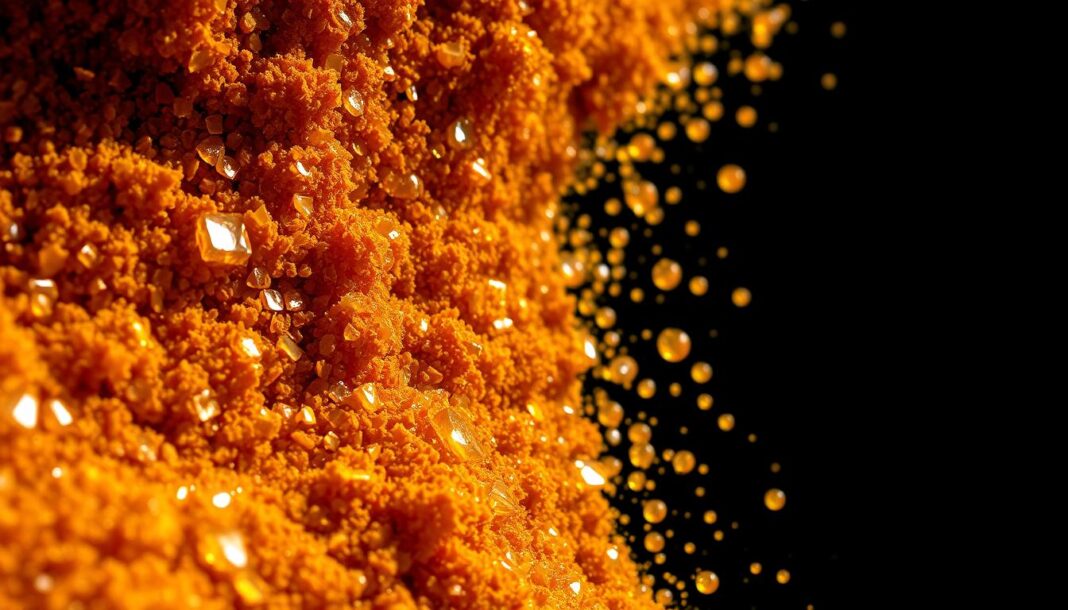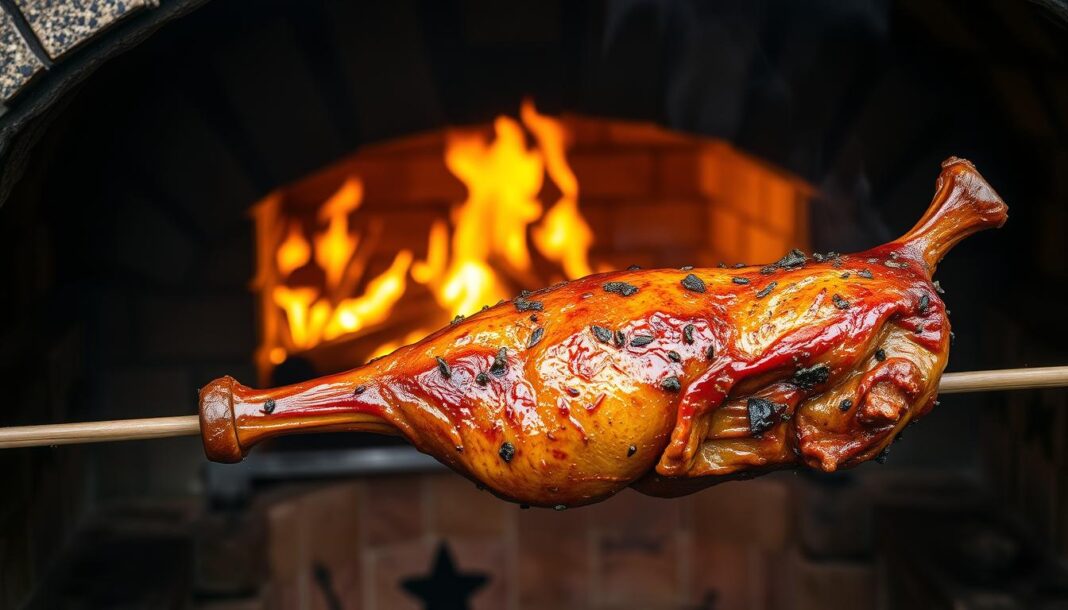In Frank Herbert’s iconic Dune series, melange, often referred to as “the spice,” plays a pivotal role as a highly valuable and sought-after substance. This psychedelic drug is known for its extraordinary properties, including extending life spans, enhancing vitality, and unlocking prescience in some individuals.
We will explore the fascinating chromatic properties of spice melange, examining both literary descriptions and visual interpretations across various media. The appearance of melange changes depending on its state – raw, processed, or in gas form – and environmental conditions, adding to its mystique.
Understanding the multifaceted nature of spice‘s coloration provides deeper insight into Herbert’s world-building and the substance’s central role in the narrative, connecting to its mystical and physiological properties.
The Diverse Color Palette of Spice Melange
The unique properties of melange result in a varied color palette, as described by Frank Herbert. The appearance of spice changes significantly depending on its state and environmental conditions on the desert planet Arrakis.
Raw Spice in Its Natural State
Raw spice, or melange, in its natural state on Arrakis, is described by Herbert in Heretics of Dune as appearing like “mounds of dark reddish brown.” The formation of spice begins with the pre-spice mass, which, after exposure to sun and air, becomes melange. This process creates distinctive “leprous blotches of violet sand” where a spice blow has erupted, as noted in Children of Dune. The interaction between the sandworms and the spice production process contributes to the unique visual characteristics of raw melange.
The environmental factors on Arrakis, including the intense heat and interaction with desert sands, significantly affect the appearance of raw spice. Under certain lighting conditions, raw melange exhibits fluorescent properties, sometimes glowing “radiant blue in dim silver light,” as observed in God Emperor of Dune.
Processed Spice Appearance
The processed form of spice or melange takes on different visual characteristics depending on its intended use, whether for consumption, commerce, or specialized applications like Guild Navigator gas. The refinement process alters the appearance of spice from its raw state to the form most commonly consumed throughout the universe.
| State of Spice | Appearance | Conditions |
|---|---|---|
| Raw | Dark reddish brown | Natural state on Arrakis |
| Pre-spice Mass | Violet sand | After spice blow eruption |
| Processed | Varies | Depending on intended use |
The diverse color palette of melange is a testament to its complex nature and the various factors influencing its appearance. Understanding these variations provides insight into the unique properties of this valuable substance, related to prescience and highly valued in the Dune universe.
What Color is Spice According to Frank Herbert’s Descriptions?
Frank Herbert’s seminal Dune series is renowned for its intricate world-building, with the mysterious spice melange being a central element. The spice is not only crucial to the plot but also a subject of fascination due to its ambiguous appearance.
Literary References to Spice Color
Herbert is vague in describing the appearance of the spice. However, in Dune Messiah, he notes that Guild Navigator Edric “swam in a container of orange gas … His tank’s vents emitted a pale orange cloud rich with the smell of the geriatric spice, melange.” This description suggests an orange hue for spice in its gaseous state. The sensory descriptions of spice consistently mention it smelling and tasting “like cinnamon,” which indirectly suggests a warm, reddish-brown color.
The comparison to cinnamon is a recurring theme across the series, starting from the first novel, Dune (1965), where Lady Jessica notes that her first taste of spice “tasted like cinnamon.” Dr. Yueh adds that the flavor is “never twice the same … It’s like life—it presents a different face each time you take it.”
Contextual Color Changes
Herbert’s descriptions indicate that spice changes color contextually based on its state, environment, and lighting conditions. This variability is reflective of the spice’s transformative nature and the different contexts in which characters encounter it.
| State of Spice | Description | Possible Color |
|---|---|---|
| Gaseous | Orange gas, pale orange cloud | Orange |
| Solid | Smells and tastes like cinnamon | Reddish-Brown |
| Various Conditions | Changes with state, environment, and lighting | Variable |
By maintaining some ambiguity about the spice’s exact appearance, Herbert allows readers to form their own mental images while providing enough detail for world-building. The changing descriptions of spice’s color throughout the Dune chronicles reflect its significance and the various ways it is encountered by characters.
The Blue Connection: Spice’s Most Iconic Color Association
One of the most striking visual elements in the Dune universe is the blue coloration associated with spice consumption. This distinctive hue becomes a hallmark of those who regularly use melange, setting them apart in a visually striking manner.
We observe this phenomenon primarily through the physical changes it induces in users. The extensive use of spice tints the sclera, cornea, and iris of the user to a dark shade of blue, a condition referred to as “blue-in-blue” or “the Eyes of Ibad.”
The Eyes of Ibad Phenomenon
The “Eyes of Ibad” is more than just a physical change; it’s a symbol of tribal bond among the Fremen. In Dune, characters like Paul Atreides initially have different eye colors, but after prolonged exposure to melange on Arrakis, their eyes take on the deep, uniform blue characteristic of the Fremen. This transformation is not just physical but also signifies their integration into Fremen society.
| Physical Change | Symbolic Meaning | Cultural Significance |
|---|---|---|
| Blue discoloration of eyes | Marker of spice addiction | Symbol of Fremen identity |
| Uniform blue eyes | Tribal belonging | Source of pride among Fremen |
Blue Glow in Certain Conditions
In certain lighting conditions, spice itself exhibits a “radiant blue” glow, as described in God Emperor of Dune. This visual connection between the substance and its effects on the human body reinforces the narrative’s emphasis on the transformative abilities of melange. The contrast between the natural reddish-brown state of spice and the blue effects it produces creates a meaningful visual dichotomy.

The blue coloration associated with spice use serves multiple narrative purposes, including identifying spice users, signaling tribal belonging, and visually representing the substance’s transformative effects. It also symbolizes the heightened prescience and expanded consciousness that spice can unlock in certain individuals.
Visual Representations of Spice in Media Adaptations
In examining media adaptations of Dune, we find that the visual portrayal of spice melange is not only aesthetically varied but also deeply connected to the narrative’s themes and technological context. The appearance of spice has been reimagined in various films, television series, and other media, reflecting different artistic approaches to translating Herbert’s descriptions into concrete images.
Spice in David Lynch’s 1984 Film
David Lynch’s 1984 film adaptation of Dune presented spice as a fine, shimmering powder with a golden-orange hue. The “spice cylinders” shown in the film contained processed, consumable spice, emphasizing its value and exclusivity among the elite of the universe. This portrayal highlighted the spice’s importance for interstellar travel and its role in extending life. The Spacing Guild and their Guild Navigators were depicted as heavily reliant on this substance.
Spice in Denis Villeneuve’s Adaptations
In contrast, Denis Villeneuve’s 2021 adaptation depicted spice melange as a glittering, cinnamon-colored substance that permeates the desert air of Arrakis. The visual effects in Villeneuve’s film emphasized the omnipresence of spice on the planet, showing how it integrates with the desert environment and the industrial processes of harvesting and refining. This portrayal underscored the spice’s crucial role in the ecosystem and economy of the Dune universe, further highlighting the importance of the Spacing Guild and their Guild Navigators.
Other Media Interpretations
Other media adaptations, including television miniseries, video games, and graphic novels, have created their own visual languages for representing spice melange. These interpretations have contributed to the rich tapestry of spice’s visual representation, influencing how organizations like the Bene Gesserit are portrayed in relation to this valuable resource. The varied visual representations reflect different artistic visions and enhance our understanding of spice’s significance in the Dune universe, supporting life and facilitating complex societal structures.
Understanding the Multifaceted Nature of Spice’s Color
The enigmatic spice melange, a cornerstone of the Dune universe, presents a kaleidoscope of colors that mirror its complex nature and diverse applications. Throughout the series, spice melange is described in various forms, from a “dark reddish-brown” substance to a glowing “radiant blue” in certain conditions, and even as an “orange gas.” This spectrum of colors is not merely aesthetic; it symbolizes the transformative properties of melange and its profound impact on the universe.
The diverse effects of spice on different groups within the Dune universe are reflected in its changing colors. For the Guild Navigators, it enables prescience for safe interstellar travel; for the Bene Gesserit, it facilitates genetic memory access and enhances their abilities. The consistent smell and taste of cinnamon provide a sensory anchor across different states and environments of melange.
The journey of characters like Paul Atreides and Leto Atreides II is mirrored in the color transformations of spice, as their eyes change color in response to their deepening connection with melange. The attempts by the Bene Tleilax to create synthetic melange represent another transformation in the substance’s nature and appearance. The cyclical connection between sandworms and spice production further underscores the complex cycle of this precious substance.
Ultimately, the changing colors of spice melange serve as a metaphor for its central role in the universe—constantly shifting yet fundamentally essential to interstellar travel, extended life, and expanded consciousness. As we conclude our exploration, it’s clear that the multifaceted nature of spice’s color is a reflection of its significance in the Dune universe.


